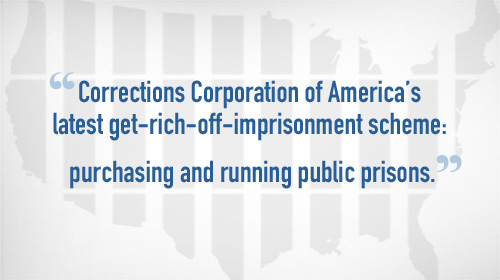States Should Run Screaming From the CCA to Avoid Dangerous and Disgusting Prisons


Given the terrifying tales coming out of Ohio’s Lake Erie Correctional Facility, states should get as far away as possible from the Corrections Corporation of America‘s (CCA) latest get-rich-off-imprisonment scheme: purchasing and running public prisons.
CCA launched this scheme one year ago, with the first private purchase of a state prison anywhere in the country. Following their purchase of Lake Erie, CCA officials wrote a bold letter to 48 governors stating that this was only the beginning – that states would line up to sell public prisons to turn a quick dime.
I’ve seen the damage the scheme has done to a community in northeastern Ohio, and I have a message for the states CCA is likely to subject to its big sales pitch: run away as fast as possible. CCA’s track record over the last year at Lake Erie amounts to an across-the board failure: burdening the local community, failing to control the escalation of dangerous conditions within prison walls, all the while ratcheting up costs despite big promises of efficiency. Let me walk you through a few of CCA’s failures.
CCA took control of Lake Erie Correctional Facility on January 1, 2012, and the problems started almost immediately. Officials in Conneaut, Ohio – where the prison is located – were surprised to learn they may be on the hook for policing the facility because state law prohibited the highway patrol from so investigating crimes in this no-longer-state-owned building. Conneaut taxpayers were not keen on CCA and the state passing the financial burden onto them, and despite the community successfully lobbying the state to change this law last year, Conneaut is still saddled with increased responsibility for policing Lake Erie.
Unfortunately, this is not where the problems end.
In September 2012, the Ohio Department of Rehabilitation and Corrections (ODRC) released its first internal audit report. If this was CCA’s first report card, let’s just say they would need to repeat the semester. The compliance rating plummeted from the 97.3% compliance rating the prison achieved when publicly-owned to 66.7%. Auditors found outrageous violations like prisoners being forced to use plastic bags for defecation and cups for urination because they had no running water for toilets. Basic conditions were heinous, with black mold, standing water, and spoiled food found throughout the prison. Perhaps even more troubling were reports that the medical department is grossly understaffed and many prisoners go untreated.
CCA attempted to cover up its terrible audit by inviting the state back in November 2012. The updated audit found many of the conditions improved – staff cleaned the black mold and replaced broken water fountains. However, the major problems like severe overcrowding, expanded use of solitary confinement, and inadequate medical care were simply left as “pending” – a polite governmental term for “not done.”
These conditions are resulting in very real problems for the prisoners and corrections officers at the facility. Only a few days after CCA released the new audit report, a prisoner died of a suspected drug overdose. This death underscores a growing problem within the prison: drugs, alcohol and other contraband are rampant throughout the facility. Conneaut police reported they fielded 248 calls regarding the prison this year, compared to only 157 over the past ten years combined.
The situation has deteriorated to the point that city police have had to set up a nightly patrol of the perimeter of the prison to apprehend people tossing contraband over the fence. Conneaut City Councilman Neil LaRusch pleaded with state officials to help the city patrol as it was costing taxpayers significantly more money.
Of course, CCA doesn’t want the people in Ohio or the 48 governors to pay attention to that. They recently announced that the prison now has accreditation from the American Correctional Association. What they failed to mention is that only a few days before the announcement, a fight broke out in the prison involving dozens of inmates – resulting in shattered windows, a prisoner with a broken leg, a prison-wide lockdown, and 39 prisoners transferred to a state prison because CCA could no longer handle them.
It’s obvious that the divide between CCA’s spin and reality is growing. If states were unsure if selling their prison to a private corporation was a bad idea before, the rapid decline of Ohio’s privately-owned prison should be proof enough that this is just a bad idea.
Learn more about private prisons and other civil liberty issues: Sign up for breaking news alerts,follow us on Twitter, and like us on Facebook.


